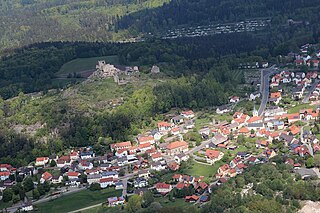
Flossenbürg is a municipality in the district of Neustadt an der Waldnaab in Bavaria in Germany. The state-approved leisure area is located in the Bavarian Forest and borders Bohemia in the east. During World War II, the Flossenbürg concentration camp was located here.

Ismaning is a municipality in Bavaria, Germany, located near Munich.
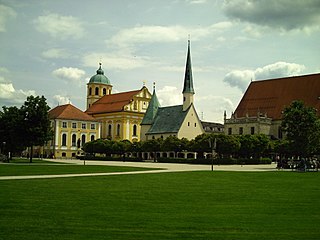
Altötting is a town in Bavaria, capital of the district Altötting of Germany. For 500 years it has been the scene of religious pilgrimages by Catholics in honor of Mary, including a visit by Pope John Paul II in 1980 and one by Pope Benedict XVI in 2006.

Ostheim vor der Rhön is a town in Northern Bavaria in the district of Rhön-Grabfeld in Franconia. Though politically part of Bavaria since 1947, it was historically a part of Thuringia, and remains religiously, architecturally, and to some extent culturally distinct from its immediate surroundings.

Regen is a town in Bavaria, Germany, and the district town of the district of Regen.
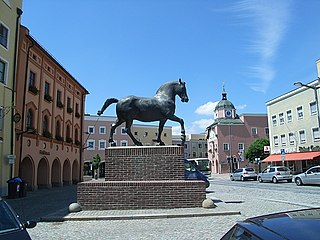
Pfarrkirchen is a municipality in southern Lower Bavaria Germany, the capital of the district Rottal-Inn. It has about 12,500 inhabitants and is an important school centre with about 10,000 pupils from all over Lower Bavaria. The town spreads over an area of about 52 square kilometers and lies approximately 377 meters above sea level. Pfarrkirchen lies at the small river "Rott", which gives the "Rottal" region its name. One of Pfarrkirchen's important industries include abattoirs which is due to the rural environment.

Donaustauf is a market town in Bavaria, 5 km (3 mi) east of Regensburg at the foothills of the Bavarian Forest. The ruins of a medieval castle, presumably erected between 914 and 930, tower above the small town. Situated nearby on a hill rising from the Danube is the imposing Teutonic temple of fame, Walhalla, a costly reproduction of the Parthenon in Athens. The Walhalla was commissioned by Ludwig I, King of Bavaria, and inaugurated on 18 October 1842.

Rimbach is a municipality in the district of Cham (district) in the Upper Palatinate in Bavaria in Germany.

Freyung is a town in Bavaria, Germany, capital of the Freyung-Grafenau district. It is situated in the Bavarian Forest mountain range, near the border with Austria and the Czech Republic.
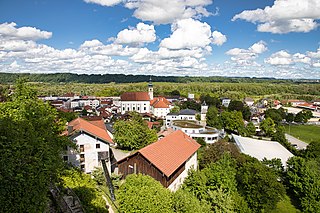
Tittmoning is a town in the district of Traunstein, in Bavaria, Germany.

Velburg is a town in the district of Neumarkt in Bavaria, Germany. It is situated 17 km southeast of Neumarkt in der Oberpfalz, and 39 km northwest of Regensburg.

Lenggries is a municipality and a town in Bavaria, Germany. It is the center of the Isarwinkel, the region along the Isar between Bad Tölz and Wallgau. The town has about 9,500 inhabitants. By area, it is the largest rural municipality ("Gemeinde") in what was formerly West Germany, and the 7th-largest overall.

Haimhausen is a municipality located on the Amper River in the district of Dachau in Bavaria, Germany, about 20 Kilometers north of Munich.
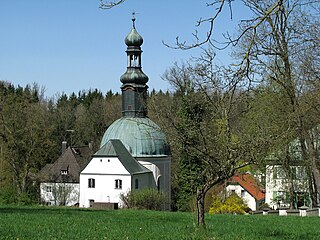
Röhrmoos is a municipality in the district of Dachau in Bavaria in Germany. It is located ca. 25 km northwest of München. The community is located between the Amper and Glonn valleys.

Heroldsberg is a municipality in the district of Erlangen-Höchstadt, in Bavaria, Germany. It is located eleven kilometers north-east from the city of Nuremberg and 23 kilometers east from Erlangen and is the headquarters of Schwan-Stabilo.
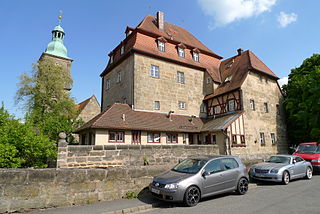
Kalchreuth is a municipality in the district of Erlangen-Höchstadt, in Bavaria, Germany. It is located 10 kilometers east of Erlangen and 15 kilometers north of Nuremberg and contains the villages of Kalchreuth, Käswasser and Röckenhof and also the hamlets of Stettenberg, Minderleinsmühle and Gabermühle.

Oberau is a municipality in the district of Garmisch-Partenkirchen, in Bavaria, Germany.
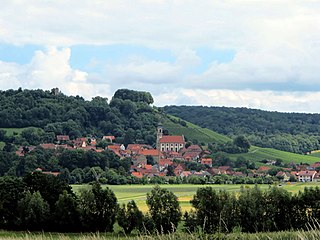
Castell is a municipality in the district of Kitzingen in Bavaria in Germany. It was the seat of the Counts of Castell. Today it is part of the municipal association Wiesentheid. It has around 800 inhabitants.
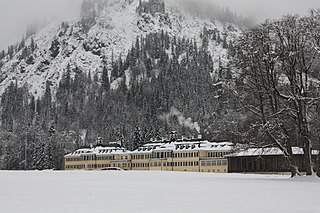
Kreuth is a municipality and a village in the district of Miesbach in Bavaria in Germany.

Weichs is a municipality in the district of Dachau in Bavaria in Germany. There are 4 main villages in the municipality - Weichs, Aufhausen, Ebersbach, and Fränking. In addition, there are several smaller villages: Albertshof, Biechlhof, Breitenwiesen, Daxberg, Edenholzhausen, Edenpfaffenhofen, Erlbach, Erlhausen, Hölzböck, Jedenhofen, and Zillhofen.

























